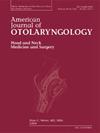Diagnosis and treatment of cerebrospinal fluid rhinorrhea with intracranial hypertension
IF 1.7
4区 医学
Q2 OTORHINOLARYNGOLOGY
引用次数: 0
Abstract
Purpose
We aimed to evaluate the impact of intracranial pressure on the prognosis of cerebrospinal fluid (CSF) rhinorrhea repair surgeries, identify critical diagnostic considerations for CSF rhinorrhea associated with intracranial hypertension, and provide insights into developing effective, individualized treatment strategies for these patients.
Methods
We analyzed the clinical data of 16 confirmed and 5 suspected cases of CSF rhinorrhea with intracranial hypertension treated at our hospital from 2015 to 2021. We documented trends in intracranial pressure before and after surgical intervention, assessed clinical manifestations, and investigated the influence of CSF shunting on patient outcomes.
Results
Among the CSF rhinorrhea patients, 8 cases experienced relapse, 18 achieved full recovery, and 3 succumbed to their conditions. All three deceased patients had severe craniocerebral trauma complicated by intracranial infections, hydrocephalus, or pneumocephalus both before and after surgery. These patients underwent multiple relapses and repeated surgical interventions. Two cases of traumatic CSF rhinorrhea with intracranial hypertension were associated with intracranial infection and hydrocephalus. Both were successfully treated with surgery following preoperative lumbar drainage. The remaining five relapsed patients (three iatrogenic and two traumatic cases) underwent CSF shunting to control intracranial pressure and were subsequently cured through additional conservative or surgical interventions. The six confirmed and five suspected cases of spontaneous CSF rhinorrhea were managed with routine lumbar drainage and continuous intracranial pressure monitoring until stabilization. All these patients were successfully treated with surgery.
Conclusion
Intracranial hypertension plays a critical role in the pathogenesis and surgical failure of CSF rhinorrhea. In cases of severe craniocerebral trauma with hydrocephalus and dilated ventricles, modifying CSF circulation before surgery is essential for effective management. Spontaneous CSF rhinorrhea strongly correlates with intracranial hypertension. Precise evaluation and appropriate management of intracranial hypertension are vital for improving patient outcomes in CSF rhinorrhea cases.
颅内高压脑脊液鼻漏的诊断与治疗
目的:评估颅内压对脑脊液(CSF)鼻漏修复手术预后的影响,确定颅内高压相关脑脊液鼻漏的关键诊断因素,并为这些患者制定有效的个性化治疗策略提供见解。方法对我院2015 - 2021年收治的脑脊液鼻漏合并颅内高压16例确诊病例和5例疑似病例的临床资料进行分析。我们记录了手术干预前后颅内压的变化趋势,评估了临床表现,并研究了脑脊液分流对患者预后的影响。结果脑脊液鼻漏患者复发8例,完全恢复18例,病死3例。所有3例死亡患者术前和术后均有严重颅脑外伤并颅内感染、脑积水或脑气。这些患者经历了多次复发和反复的手术干预。外伤性脑脊液鼻漏合并颅内高压合并颅内感染及脑积水2例。两例患者均在术前腰椎引流后成功手术治疗。其余5例复发患者(3例医源性和2例外伤性)接受脑脊液分流以控制颅内压,随后通过额外的保守或手术干预治愈。6例确诊病例和5例疑似自发性脑脊液鼻漏病例均行腰椎常规引流和持续颅内压监测,直至病情稳定。所有患者均成功接受手术治疗。结论颅内高压在脑脊液鼻漏的发病和手术失败中起关键作用。在严重颅脑外伤合并脑积水和脑室扩张的病例中,术前调整脑脊液循环是有效治疗的必要条件。自发性脑脊液鼻漏与颅内高压密切相关。颅内高压的精确评估和适当的管理对于改善脑脊液鼻漏病例的患者预后至关重要。
本文章由计算机程序翻译,如有差异,请以英文原文为准。
求助全文
约1分钟内获得全文
求助全文
来源期刊

American Journal of Otolaryngology
医学-耳鼻喉科学
CiteScore
4.40
自引率
4.00%
发文量
378
审稿时长
41 days
期刊介绍:
Be fully informed about developments in otology, neurotology, audiology, rhinology, allergy, laryngology, speech science, bronchoesophagology, facial plastic surgery, and head and neck surgery. Featured sections include original contributions, grand rounds, current reviews, case reports and socioeconomics.
 求助内容:
求助内容: 应助结果提醒方式:
应助结果提醒方式:


